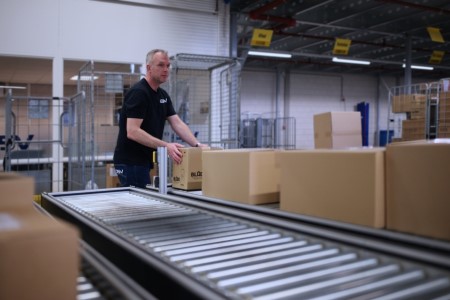The growing trend of eco-friendly packaging in courier services
In recent years, the courier industry has seen a significant shift towards eco-friendly packaging, driven by an increasing awareness of environmental issues and a shift in consumer preferences. This trend is not merely a nod to eco-consciousness but a strategic move to align with global sustainability goals and enhance brand loyalty among environmentally aware consumers. As the demand for more sustainable business practices grows, courier companies are reevaluating their packaging solutions, focusing on reducing environmental impact without compromising on efficiency and cost-effectiveness.

The embrace of sustainable packaging reflects a broader shift within industries worldwide to mitigate environmental damage caused by business operations. For courier services, this shift is not just about adopting new materials but also about rethinking logistics and delivery processes to enhance sustainability. By integrating eco-friendly packaging, courier companies can reduce their carbon footprint, minimise waste, and appeal to a growing segment of consumers who prioritise environmental responsibility in their purchasing decisions.
Why is sustainability important in logistics?
Sustainability in logistics has become a crucial competitive factor, influencing both company policies and consumer choices. As logistics operations contribute significantly to carbon emissions and environmental degradation, companies are under increasing pressure to adopt greener practices. This pressure comes not only from regulatory bodies but also from customers who are becoming more environmentally conscious. Companies that prioritise sustainability can improve their public image, meet regulatory requirements, and potentially lower operational costs.
Incorporating sustainability into logistics involves rethinking supply chain management, from vehicle fuel efficiency to packaging materials. By reducing waste and enhancing resource efficiency, companies can achieve greater sustainability. These practices not only help protect the environment but also boost operational efficiencies and can lead to cost savings over time, for instance, through reduced waste disposal fees and enhanced customer loyalty.
What is eco-friendly packaging?
Eco-friendly packaging refers to the use of materials and production methods that have minimal environmental impact. This type of packaging is designed to be sustainable throughout its lifecycle, from production to disposal. It typically involves materials that are biodegradable, recyclable, or derived from renewable resources. Common examples include recycled paper, bioplastics, and materials sourced from sustainably managed forests.
The key difference between eco-friendly packaging and traditional packaging lies in the consideration of environmental impact during the design and manufacturing processes. Eco-friendly packaging aims to reduce the use of toxic materials, minimise waste, and lower greenhouse gas emissions. It also focuses on improving the efficiency of resource use, such as reducing the amount of material needed per package or using materials that are more readily renewable.
What are the benefits of eco-friendly packaging?
The environmental benefits of using eco-friendly packaging are clear: it reduces waste, minimises pollution, and decreases the depletion of non-renewable resources. From an economic perspective, while the initial investment in sustainable packaging solutions might be higher, these costs are often offset by the long-term savings associated with waste reduction, material efficiency, and improved brand image. Additionally, sustainable packaging often requires less energy to produce and dispose of, further reducing its environmental impact.
Socially, companies that adopt eco-friendly packaging demonstrate corporate responsibility, which can enhance brand loyalty and customer satisfaction. This shift can also lead to new market opportunities as consumer demand for sustainable products grows. Furthermore, using sustainable packaging can help companies comply with increasing regulatory demands focused on environmental protection, thereby avoiding fines and facilitating smoother operations across borders.
Challenges faced by courier services
Transitioning to eco-friendly packaging presents several challenges for courier services. The primary hurdle is the cost implication, as sustainable materials can be more expensive than conventional alternatives. This cost factor can be particularly challenging for small to medium-sized enterprises that operate on tight margins. Additionally, integrating sustainable packaging requires changes in supply chain management, from sourcing materials to adjusting packaging processes, which can disrupt established operations.
Another significant challenge is the need for education and training for employees about sustainable practices and the benefits of eco-friendly packaging. There is also the issue of scalability and the availability of sustainable materials, as the demand can sometimes outstrip supply. Furthermore, companies must ensure that their shift to eco-friendly packaging does not compromise the protective quality of the packaging, as the primary function of packaging—protecting goods during transit—must still be met efficiently.
Government regulations and eco-packaging
Government policies play a pivotal role in encouraging the use of eco-friendly packaging. In many regions, legislation is increasingly mandating the reduction of environmental impact by businesses, including stricter waste management and recycling requirements. These regulations can include incentives for companies that adopt sustainable practices, such as tax breaks or subsidies, as well as penalties for those that fail to comply with environmental standards.
These governmental actions help level the playing field, making it more economically viable for companies to invest in eco-friendly packaging. Additionally, international agreements and regional policies can drive standardisation in packaging requirements, which helps to reduce confusion and streamline the adoption of sustainable practices across borders. This regulatory environment not only supports environmental goals but also encourages innovation in the development of new, sustainable packaging solutions.
What are the latest technological advancements in packaging?
Technological innovation is critical to advancing eco-friendly packaging solutions in the courier industry. Recent developments include the creation of bio-based packing materials and improvements in recycling technologies that make it easier and more cost-effective to reuse materials. Innovations such as 3D printing have also opened up new possibilities for creating custom packaging solutions that reduce waste by using precise amounts of material.
Moreover, advancements in material science have led to the development of composites and coatings that enhance the durability and recyclability of packaging. These technologies allow for the production of lighter, stronger packaging that meets the demands of modern logistics operations without compromising on environmental sustainability. As technology continues to evolve, it is expected that more sophisticated and environmentally friendly packaging solutions will become available, further transforming the logistics industry.
Consumer preferences and market trends
Consumer demand for sustainable products is reshaping the packaging strategies of courier services. Today, a significant portion of consumers prefer to buy products from companies that demonstrate environmental responsibility, including sustainable packaging. This shift in consumer preferences is reflected in market trends that show a growing market share for products with green packaging.
Courier services are responding to this trend by not only adopting eco-friendly packaging but also by using their commitment to sustainability as a marketing tool. As consumers become more environmentally savvy, they seek out transparency in the sustainability claims of companies. This has prompted courier services to not only implement sustainable packaging solutions but also to communicate their environmental efforts more effectively to their customers.
What is the role of recycling and reusability?
Designing packaging with recycling and reusability in mind is crucial for enhancing the environmental benefits of eco-friendly practices. Packaging that is designed to be recycled helps reduce the amount of waste that ends up in landfills and facilitates the reuse of materials, which can significantly lower the environmental impact of packaging. Furthermore, designing for reusability can extend the lifecycle of packaging materials, further reducing the need for new raw materials and the energy consumed in production.
For courier services, implementing strategies that encourage the return and reuse of packaging can not only enhance sustainability but also build customer loyalty. Programs that incentivise customers to return packaging for reuse or recycling can be an effective way to engage consumers in a company's sustainability efforts. Additionally, such programs can provide valuable insights into consumer behaviour and preferences, which can inform future packaging and marketing strategies.
How does eco-friendly packaging compare to traditional packaging?
Eco-friendly packaging often stands in stark contrast to traditional packaging methods, which typically rely on materials that are harmful to the environment. Traditional packaging solutions usually involve plastics and other materials that are not biodegradable and are difficult to recycle, contributing significantly to environmental pollution and waste. In contrast, eco-friendly packaging uses materials that are either biodegradable or easier to recycle, and which have a lower environmental impact during production and disposal.
A comparative analysis of both types of packaging shows that while eco-friendly packaging may sometimes be more costly initially, it offers greater long-term benefits in terms of sustainability and compliance with global environmental standards. Moreover, as the technology and materials for sustainable packaging continue to improve, the cost differential is expected to decrease, making eco-friendly options increasingly competitive.
What's the future of eco-friendly packaging?
The future of eco-friendly packaging in the courier industry looks promising. With ongoing technological advancements and increasing consumer demand for sustainability, it is likely that the use of sustainable packaging materials will become more widespread. The continued development of new materials and processes is expected to reduce costs and improve the efficiency and effectiveness of eco-friendly packaging.
Furthermore, as global awareness of environmental issues continues to grow, we can expect more stringent regulations promoting sustainable practices. This regulatory environment will further drive innovation and investment in eco-friendly packaging technologies. The courier industry, therefore, stands at the forefront of a significant shift towards sustainability that could set standards for other sectors as well.
Why is eco-friendly packaging important?
The growing importance of eco-friendly packaging in the courier industry reflects a broader trend towards sustainability in global business practices. As consumers become more environmentally conscious, businesses are adapting by implementing sustainable solutions that meet both ecological and economic needs. The benefits of eco-friendly packaging are clear: reduced environmental impact, enhanced customer loyalty, and compliance with regulatory standards. However, the transition requires overcoming challenges such as cost and supply chain adaptations. Despite these challenges, the future of eco-friendly packaging looks bright, with ongoing innovations promising to enhance its feasibility and effectiveness. The courier industry's move towards sustainable packaging is not just a trend but a fundamental shift that is likely to continue shaping the industry's future.
